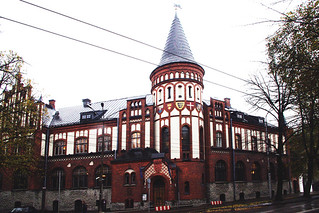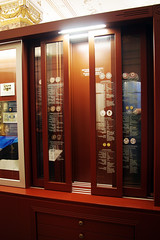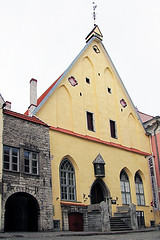
PREV ARTICLE
NEXT ARTICLE
FULL ISSUE
PREV FULL ISSUE
HOWARD BERLIN VISITS TALLINN, ESTONIANumismatourist Howard Berlin submitted his latest report for E-Sylum
readers, this time from Tallinn, Estonia. Thanks! -Editor
A previous article in The E-Sylum was about my visit to two museums in Vilnius. Leaving Vilnius after four days, I flew to Tallinn, Estonia with a brief stopover to change planes in Riga, Latvia.
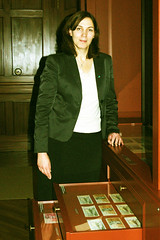 
Siiri Ries; Bank of Estonia Museum spiral staircase The museum is in the former building of the bank of the Credit Society of the Estonian Knighthood. Built in 1904, at the time it represented the first modern purpose-built bank in Tallinn and was fully transferred to the Bank of Estonia in 1998. Renovations in 2010 allowed the museum to occupy approximately 4,000 square feet (370 square meters). There are three exhibition halls: Aadlisaal (Hall of Nobility), Peasant, and the Treasury Center. All have a little piece of hidden history in each one. Computer animation is used to explain the meaning of money, the role of the Viking trade, and Estonian participation in world trade in the 9th-10th centuries.
Visitors can also see a historic gold bar of the Bank of Estonia from 1922 that was part of the reserves backing the kroon during the first Republic of Estonia and also during re-independence. The historic gold bar was delivered to Estonia in December 2011 by the Federal Reserve Bank of New York.
The exhibition, documenting the money used in the former Livonia up to the present-day independent Estonia, covers six time periods: Viking Age, 800-1200 AD; Middle Ages, 1200-1561 AD; Early Modern Period, 1591-1710 AD; Late Modern Period, 1710-1800 AD; Late Modern Period, 1800-1918 AD; and Contemporary History, 1918-2011 AD. 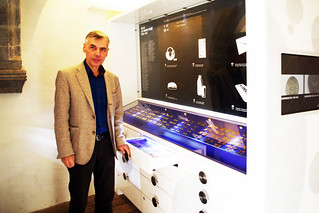
Estonian History Museum numismatic curator Dr Ivar Leimus Before heading home, I flew to London for an overnight stay. While there I met up with Michael Alexander who writes for the on-line sites CoinNews and Coin Update. Besides reporting on numismatic news, Michael also occasionally visits and writes about numismatic museums. Michael has visited the Tallinn museums several times and I was able to pass on regards from Siiri and Ivar. We traded some travel “war stories” over faux milkshakes at a McDonalds on High Street Kensington. Later that day I also met up with a nephew and his girlfriend who both live in London’s Hampstead Village. We had dinner at Goodman Restaurant, a steakhouse in on Maddox Street in the Mayfair district. This time, I got hit with the bill – £238 ($381) for a party of three! I was debating between paying with five crisp, new £50 notes I recently got from the Bank of England or using plastic. Payment using the credit card won, thereby allowing me to collect my frequent flyer miles on British Air. To read the earlier E-Sylum article, see:
Wayne Homren, Editor The Numismatic Bibliomania Society is a non-profit organization promoting numismatic literature. See our web site at coinbooks.org. To submit items for publication in The E-Sylum, write to the Editor at this address: whomren@gmail.com To subscribe go to: https://my.binhost.com/lists/listinfo/esylum All Rights Reserved. NBS Home Page Contact the NBS webmaster 
|
